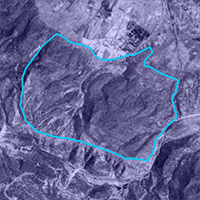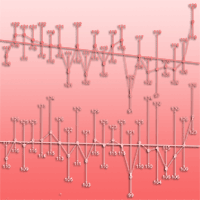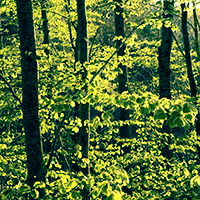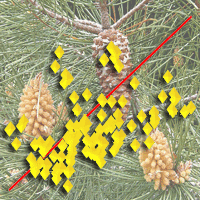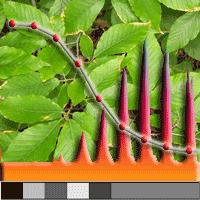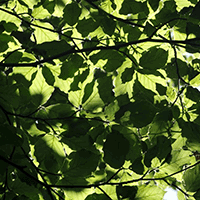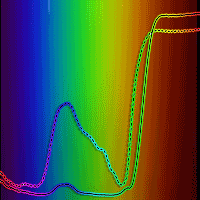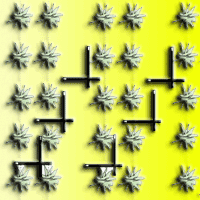
A comparative study of four approaches to assess phenology of Populus in a short-rotation coppice culture
Stefan PP Vanbeveren (1) , Jasper Bloemen (1-2), Manuela Balzarolo (1), Laura S Broeckx (1), Isabele Sarzi-Falchi (1-3), Melanie S Verlinden (1), Reinhart Ceulemans (1)
iForest - Biogeosciences and Forestry, Volume 9, Issue 5, Pages 682-689 (2016)
doi: https://doi.org/10.3832/ifor1800-009
Published: May 12, 2016 - Copyright © 2016 SISEF
Research Articles
Abstract
We compared four approaches to assess phenology in a short-rotation coppice culture with 12 poplar (Populus) genotypes. The four approaches quantified phenology at different spatial scales and with different temporal resolutions: (i) visual observations of bud phenology; (ii) measurements of leaf area index; (iii) webcam images; and (iv) satellite images. For validation purposes we applied the four approaches during two years: the year preceding a coppice event and the year following the coppice event. The delayed spring greenup and the faster canopy development in the year after coppicing (as compared to the year before coppicing) were similarly quantified by the four approaches. The four approaches detected very similar seasonal changes in phenology, although they had different spatial scales and a different temporal resolution. The onset of autumn senescence after coppicing remained the same as in the year before coppicing according to the bud set observations, but it started earlier according to the webcam images, and later according to the MODIS images. In comparison to the year before coppicing, the growing season - in terms of leaf area duration - was shorter in the year after coppicing, while the leaf area index was higher.
Keywords
Authors’ Info
Authors’ address
Jasper Bloemen
Manuela Balzarolo
Laura S Broeckx
Isabele Sarzi-Falchi
Melanie S Verlinden
Reinhart Ceulemans
University of Antwerp, Department of Biology, Research Center of Excellence on Plant and Vegetation Ecology, Universiteitsplein 1, B-2610 Wilrijk (Belgium)
University of Innsbruck, Institute of Ecology, Research group on Ecophysiology and Ecosystem Processes, Sternwartestraβe 15, 6020 Innsbruck (Austria)
Instituto Florestal, Seção de Silvicultura, Rua do Horto 931, CEP 02377-000, São Paulo (Brazil)
Corresponding author
Paper Info
Citation
Vanbeveren SPP, Bloemen J, Balzarolo M, Broeckx LS, Sarzi-Falchi I, Verlinden MS, Ceulemans R (2016). A comparative study of four approaches to assess phenology of Populus in a short-rotation coppice culture. iForest 9: 682-689. - doi: 10.3832/ifor1800-009
Academic Editor
Silvano Fares
Paper history
Received: Aug 10, 2015
Accepted: Feb 15, 2016
First online: May 12, 2016
Publication Date: Oct 13, 2016
Publication Time: 2.90 months
Copyright Information
© SISEF - The Italian Society of Silviculture and Forest Ecology 2016
Open Access
This article is distributed under the terms of the Creative Commons Attribution-Non Commercial 4.0 International (https://creativecommons.org/licenses/by-nc/4.0/), which permits unrestricted use, distribution, and reproduction in any medium, provided you give appropriate credit to the original author(s) and the source, provide a link to the Creative Commons license, and indicate if changes were made.
Web Metrics
Breakdown by View Type
Article Usage
Total Article Views: 50547
(from publication date up to now)
Breakdown by View Type
HTML Page Views: 42108
Abstract Page Views: 2923
PDF Downloads: 4063
Citation/Reference Downloads: 43
XML Downloads: 1410
Web Metrics
Days since publication: 3500
Overall contacts: 50547
Avg. contacts per week: 101.09
Citation Metrics
Article Citations
Article citations are based on data periodically collected from the Clarivate Web of Science web site
(last update: Mar 2025)
Total number of cites (since 2016): 14
Average cites per year: 1.40
Publication Metrics
by Dimensions ©
Articles citing this article
List of the papers citing this article based on CrossRef Cited-by.
References
Vegetation phenology in central Asia by means of remote sensing. In: Proceedings of the “3rd Annual Global Change and Resilience Conference: from impacts to responses (vol. 1)” (Stojanov R, Zalud Z, Cudlin P, Farda A, Urban O, Trnka M eds). Global Change Research Centre, Academy of Sciences of the Czech Republic, vvi Brno, Czech Republic, pp. 131-135.
Online | Gscholar
Short-rotation intensive culture practices for Northern Wisconsin. In: Proceedings of the “North American Poplar Council Annual Meeting”. Thompsonville (Michigan, USA) 1979. Staff of Intensive Culture Project, USA, pp. 47-63.
Gscholar
Evaluation of the potential of MODIS satellite data to predict vegetation phenology in different biomes: an investigation using ground-based NDVI measurements. Remote Sensing of Environment 132: 145-158.
CrossRef | Gscholar
Using digital repeat photography and eddy covariance data to model grassland phenology and photosynthetic CO2 uptake. Agricultural and Forest Meteorology 151: 1325-1337.
CrossRef | Gscholar
Ecotypic variation of the photoperiodic response in Populus. Journal of the Arnold Arboretum 35: 167-188.
Gscholar
R: a language and environment for statistical computing. R foundation for statistical computing, Vienna, Austria.
Gscholar
Bud set in poplar - genetic dissection of a complex trait in natural and hybrid populations. New Phytologist 189: 106-121.
CrossRef | Gscholar
Monitoring vegetation systems in the Great Plains with Erts. In: Proceedings of the “3rd Earth Resources Technology Satellite-1 Symposium- Volume I: Technical Presentations” (Freden SC, Mercanti EP, Becker MA eds). Goddard Space Flight Center (Washington, DC, USA) 10-14 Dec 1973. NASA SP-351, Washington, DC, USA, pp. 309-317.
Online | Gscholar
Phenology: an integrative environmental science. SpringerLink, Dordrecht, the Netherlands, pp. 610.
Gscholar
Ground-based network of NDVI measurements for tracking temporal dynamics of canopy structure and vegetation phenology in different biomes. Remote Sensing of Environment 123: 234-245.
CrossRef | Gscholar
Evaluation of the onset of green-up in temperate deciduous broadleaf forests derived from Moderate Resolution Imaging Spectroradiometer (MODIS) data. Remote Sensing of Environment 112: 2643-2655.
CrossRef | Gscholar
The impact of gridding artifacts on the local spatial properties of MODIS data: implications for validation, compositing, and band-to-band registration across resolutions. Remote Sensing of Environment 105: 98-114.
CrossRef | Gscholar



